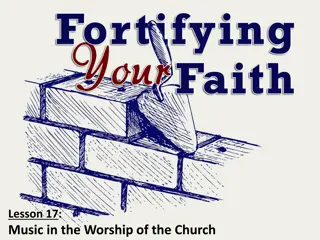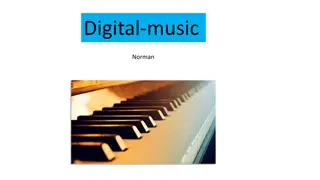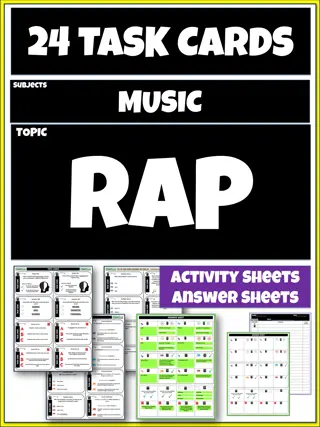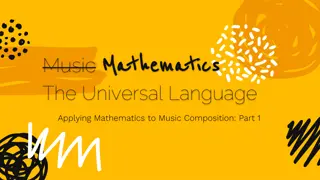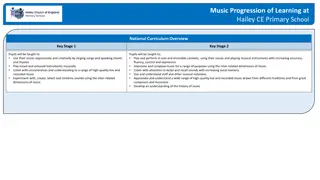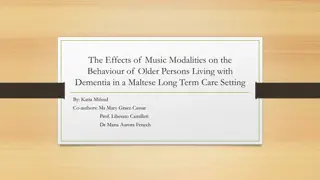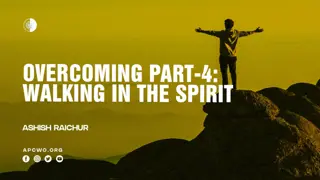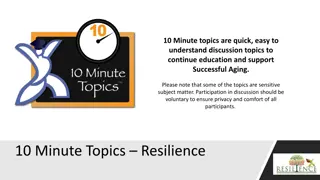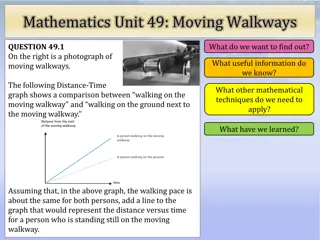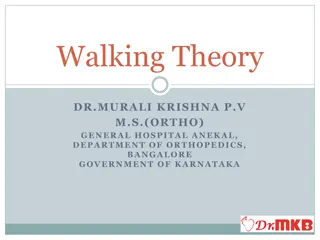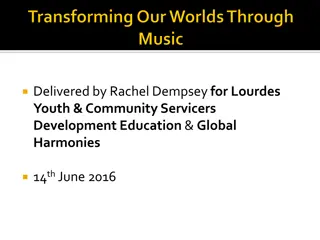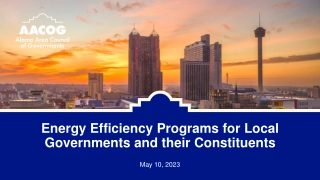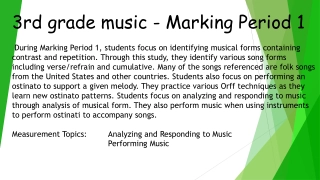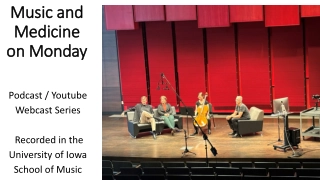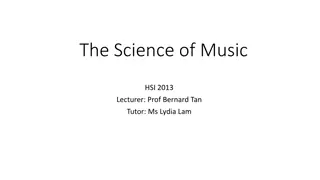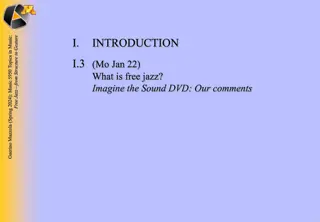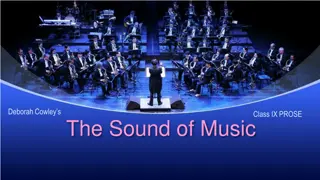Psychophysiological Effects of Music on Walking Pace in Sedentary Individuals
This research investigates the impact of music on heart rate, perceived exertion, feelings scale, and walking distance during self-selected walking pace in sedentary individuals. Results show significant interactions in heart rate and perceived exertion among groups, while no notable differences were found in walking distance and feelings scale.
Download Presentation

Please find below an Image/Link to download the presentation.
The content on the website is provided AS IS for your information and personal use only. It may not be sold, licensed, or shared on other websites without obtaining consent from the author. Download presentation by click this link. If you encounter any issues during the download, it is possible that the publisher has removed the file from their server.
E N D
Presentation Transcript
RESEARCH TITLE : THE PSYCHOPHYSIOLOGICAL EFFECTS OF MUSIC ON SELF-SELECTED WALKING PACE IN SEDENTARY PEOPLE HAZIQ IZZUDDIN BIN ZAMRIN SPORT SCIENCE AND RECREATION, UiTM
INTRODUCTION Physical activity refers to any movement that involves the use of muscles and bones including walking, running, swimming, cycling, playing sports, and participating in fitness classes, and has numerous benefits for both the body and mind (Erickson et al., 2013). Music has a significant impact on physical activity by increasing motivation, improving performance, and enhancing enjoyment (Stork et al., 2015). Sedentary individuals engage in a lifestyle that involves little or no physical activity because of boredom and tiredness (Verschuren et al., 2016) and music may help encourage a healthy lifestyle with less demanding and more fun physical activity. There is conflicting evidence on the effect of fast music on exercise performance and fatigue (Atan, 2013). Some studies have shown that fast music can improve performance and delay fatigue, while others have found no such effect (Guo et al., 2015). This study is to investigate the effects of music on heart rate (HR), rate perceived exertion (RPE), feelings scale (FS), and walking distance (WD) during self-selected walking pace in sedentary individuals.
METHODS Research design: Controlled experimental design, with N=18 sedentary participants randomly assigned to two groups: a control group and an experimental group. Control group = N (18) not listen to music, while the experimental group = N (18) listen to fast beat music (120 140 bpm) during their self-selected walking pace. The participant's heart rate, rate perceived exertion, feelings scale, and walking distance were recorded at four time periods: minute 15, minute 25, minute 35, and minute 45 during the walking test (Almeida et al., 2015).
RESULT The results revealed that music have a significant interaction between group on heart rate (HR), rate perceived exertion (RPE), between four times period during the test (p < 0.05). However, there is no significant difference between music on walking distance (WD). and feelings scale (FS) Mean value for Music on HR
RESULT The results revealed that music have a significant interaction between group on heart rate (HR), rate perceived exertion (RPE), between four times period during the test (p < 0.05). However, there is no significant difference between music on walking distance (WD). and feelings scale (FS) Mean value for Music on RPE
RESULT The results revealed that music have a significant interaction between group on heart rate (HR), rate perceived exertion (RPE), between four times period during the test (p < 0.05). However, there is no significant difference between music on walking distance (WD). and feelings scale (FS) Mean value for Music on FS Mean value for Music on WD
DISCUSSION The results revealed that exercise with music influence physiology and psychological effects towards human body which HR and RPE Supported study: Listening to music affects the activity of the autonomic nervous system (ANS), which controls various bodily functions, including heart rate. According to studies, music can reduce sympathetic nervous system (SNS) activity, which is responsible for the "fight-or-flight" response, while increasing parasympathetic nervous system (PNS) activity, which promotes relaxation (Kirk et al., 2022; Wu & Chang, 2021) The rhythmic synchronisation of fast-paced music with physical activity may also have a stimulating impact on the body, boosting increased effort and decreased perceived exertion (Aburto-Corona et al., 2021).
DISCUSSION The results revealed that exercise with music influence physiology and psychological effects towards human body which FS. However, music doesn t influence WD. Supported study: Heightened arousal can also contribute to an improved emotional state and a more enjoyable workout (Ganesh & Surya, 2020). Self-selected walking pace may be less structured and more variable, making it less susceptible to music's effects (Sawers et al., 2015).
CONCLUSION Overall results for null hypothesis were rejected because there was a significant effect of music on HR, RPE, and FS among sedentary population in UiTM Seremban hypothesis for a significant difference effect of music on walking distance (WD) fails to reject null hypothesis because there is no significant difference effect. 3. However, the null Music can serve as an intervention for the general population, particularly those leading sedentary lifestyles, to promote a healthier way of living by incorporating strenuous physical activities and improving overall performance for athletes. enjoyable, less
REFERENCES Almeida, F. A. M., Nunes, R. F. H., Ferreira, S. dos S., Krinski, K., Elsangedy, H. M., Buzzachera, C. F., Alves, R. C., & Gregorio da Silva, S. (2015). Effects of musical tempo on physiological, affective, and perceptual variables and performance of self-selected walking pace. Journal of Physical Therapy Science, 27(6), 1709 1712. https://doi.org/10.1589/jpts.27.1709 Atan, T. (2013). Effect of music on anaerobic exercise performance. Biology of Sport, 30(1), 35 39. https://doi.org/10.5604/20831862.1029819 Erickson, K. I., Gildengers, A. G., & Butters, M. A. (2013). Physical activity and brain plasticity in late adulthood. Dialogues in Clinical Neuroscience, 15(1), 99 108. https://doi.org/10.31887/DCNS.2013.15.1/kerickson Fu, W., Wang, C., Zou, L., Guo, Y., Lu, Z., Yan, S., & Mao, J. (2020). Psychological health, sleep quality, and coping styles to stress facing the COVID-19 in Wuhan, China. Translational Psychiatry, 10(1), 225. https://doi.org/10.1038/s41398-020-00913-3 Stork, M. J., Kwan, M. Y. W., Gibala, M. J., & Martin Ginis, K. A. (2015). Music enhances performance and perceived enjoyment of sprint interval exercise. Medicine & Science in Sports & Exercise, 47(5), 1052 1060. https://doi.org/10.1249/MSS.0000000000000494
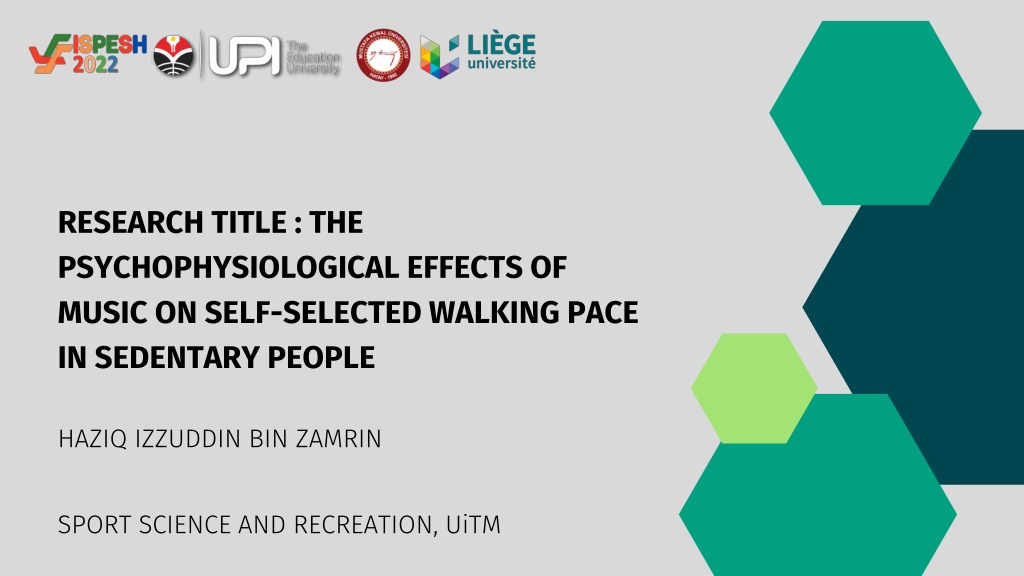

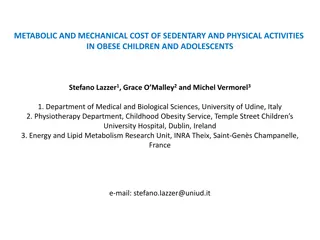
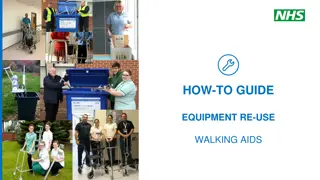
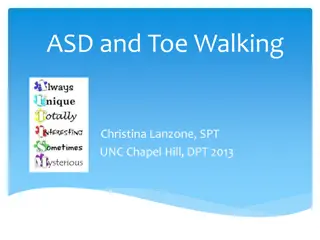
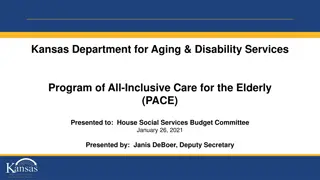

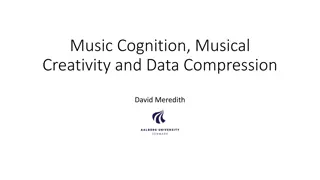

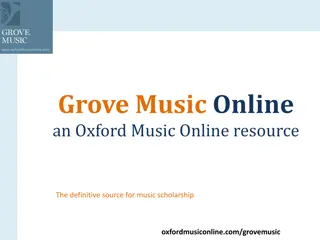


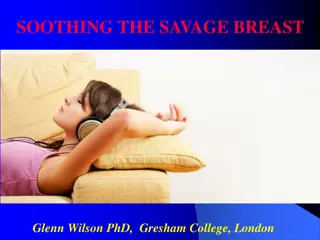

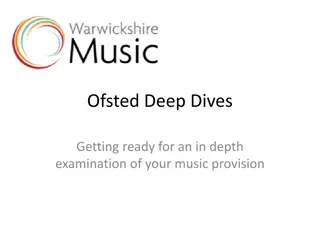
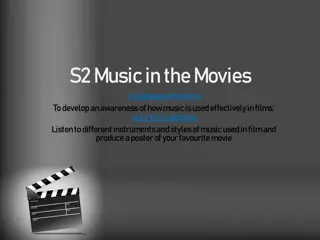
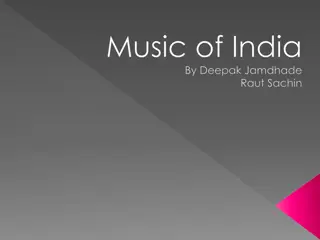

![Explore the Exciting World of Live Music Through [Insert Town/City] Census!](/thumb/148894/explore-the-exciting-world-of-live-music-through-insert-town-city-census.jpg)
